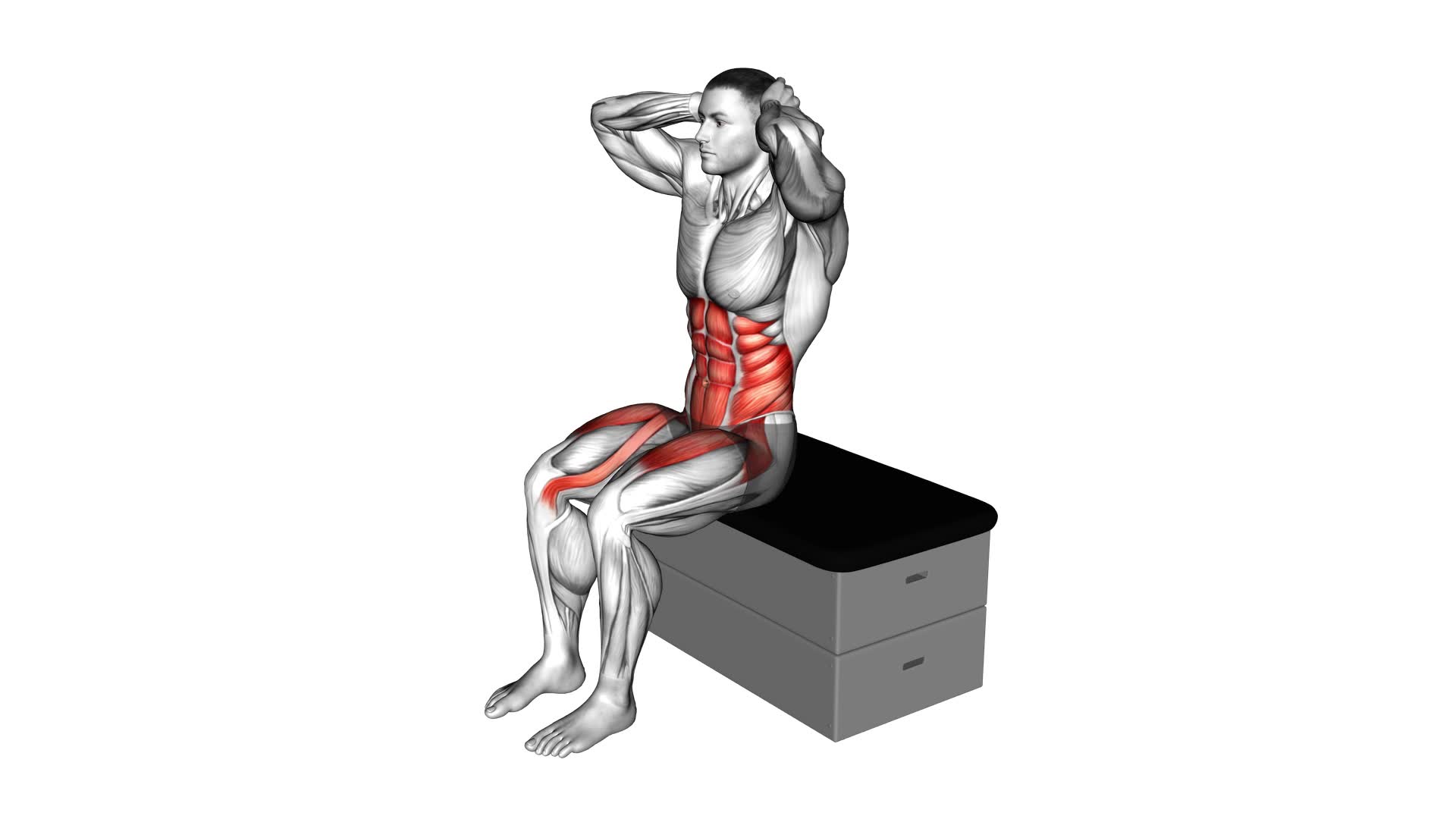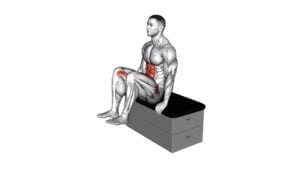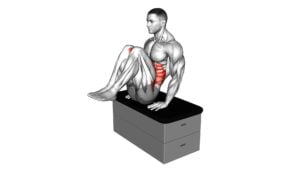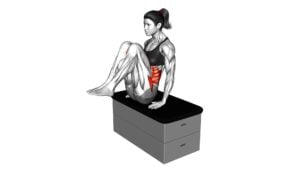Sitting Twist Knee Raise on a Padded Stool – Video Exercise Guide & Tips

Are you looking for a quick and effective exercise to target your core and improve flexibility? Look no further than the Sitting Twist Knee Raise on a Padded Stool.
Watch This Exercise Video
This exercise is perfect for anyone wanting to tone their abs and obliques. In just a few minutes a day, you can strengthen your core and increase your range of motion.
Follow our video guide and tips to ensure proper form and get the most out of this exercise.
Key Takeaways
- The sitting twist knee raise strengthens core muscles and improves balance and stability.
- Proper form and technique, such as sitting tall with a straight back and engaged core, are important to avoid common mistakes and potential injuries.
- Modifications and progressions, such as starting with feet touching the ground for added stability or using a dumbbell for added difficulty, can be made to tailor the exercise to different fitness levels.
- It is important to maintain proper form and technique during the exercise to ensure safety and effectiveness, and to gradually increase the intensity to prevent overexertion.
Benefits of the Sitting Twist Knee Raise
One of the main benefits of the Sitting Twist Knee Raise is that it strengthens your core muscles. Your core muscles play a crucial role in stabilizing your body and supporting your spine. By engaging these muscles during the exercise, you can improve your overall core strength. This is important because a strong core can enhance your balance and stability, reduce the risk of injuries, and improve your posture.
Additionally, the Sitting Twist Knee Raise also helps to improve flexibility. As you twist your upper body and bring your knees towards your chest, you're stretching and lengthening your muscles. This exercise targets the muscles in your lower back, hips, and abdomen, promoting flexibility in these areas. Increased flexibility can improve your range of motion, making everyday movements easier and more fluid. It can also reduce muscle tension and tightness, alleviating discomfort and improving your overall mobility.
Proper Form and Technique
To perform the Sitting Twist Knee Raise with proper form and technique, position yourself on a padded stool and follow these steps:
- Sit up tall on the stool, ensuring that your back is straight and your core is engaged.
- Place your hands on the sides of the stool for stability.
- Bend your knees slightly and lift your feet off the ground, keeping them together.
Slowly twist your upper body to the right, bringing your right knee towards your chest.
- Return to the starting position and repeat the movement, this time twisting to the left and bringing your left knee towards your chest.
When performing the Sitting Twist Knee Raise, it's important to avoid these common mistakes:
- Allowing your back to hunch forward: Remember to keep your back straight throughout the exercise to maintain proper form.
- Using momentum to lift your knees: Focus on using your abdominal muscles to lift your knees instead of relying on momentum.
- Holding your breath: Remember to breathe continuously throughout the exercise to ensure proper oxygen flow to your muscles.
Modifications and progressions for the Sitting Twist Knee Raise include:
- Beginners can start by performing the exercise with their feet touching the ground for added stability.
- Advanced individuals can increase the difficulty by holding a dumbbell or medicine ball while performing the exercise.
Now that you know the proper form and technique for the Sitting Twist Knee Raise, let's move on to discussing the equipment needed for the exercise.
Equipment Needed for the Exercise
To perform the Sitting Twist Knee Raise exercise, you'll need some essential equipment. This includes a padded stool or chair that's sturdy and stable to support your weight.
Alternatively, if you have limited space or don't have access to a padded stool, you can use a yoga block or a folded towel as a substitute.
Essential Exercise Equipment
You will need specific exercise equipment to perform the Sitting Twist Knee Raise on a Padded Stool. Here are some exercise equipment options you can consider:
- Padded Stool: A stable and comfortable stool with padding is essential for this exercise, as it provides support and prevents discomfort during the movement.
- Resistance Band: Adding a resistance band to this exercise can increase the difficulty and intensity. It helps to strengthen your muscles and improve flexibility.
- Ankle Weights: Ankle weights can be used to add extra resistance to the exercise, targeting your leg muscles and making the movement more challenging.
- Exercise Mat: Having an exercise mat underneath the padded stool can provide cushioning and prevent any slipping or sliding during the exercise.
Using the proper exercise equipment is important to ensure safety and effectiveness during the Sitting Twist Knee Raise on a Padded Stool.
Now, let's explore alternatives for limited space.
Alternatives for Limited Space
If you're working with limited space, there are alternative exercise equipment options you can consider for the Sitting Twist Knee Raise on a Padded Stool.
Small space alternatives for this exercise include using a stability ball or an exercise band. Instead of a padded stool, you can sit on the stability ball, which not only engages your core muscles but also improves your balance and stability.
If you prefer to stay seated on a chair, you can use an exercise band for resistance. Secure the band around the chair and perform the knee raise motion while holding onto the band.
Both of these alternatives allow you to perform seated core exercises in a small space.
Now let's move on to the next section, where we'll discuss modifications and progressions for this exercise.
Modifications and Progressions
For modifications and progressions of the sitting twist knee raise on a padded stool, consider incorporating variations that challenge your core stability and increase the difficulty of the exercise. Here are some options to try:
- Single-leg knee raise: Instead of lifting both knees at the same time, raise one knee while keeping the other foot on the ground. This variation increases the demand on your core muscles and improves balance.
- Weighted knee raise: Hold a dumbbell or a medicine ball against your chest while performing the knee raise. The added weight increases the resistance and intensifies the exercise.
- Side plank knee raise: Begin in a side plank position with your forearm on the ground and your body in a straight line. Lift your top leg and bring your knee towards your chest, engaging your obliques. This modification targets your core muscles from a different angle.
- Plyometric knee raise: Instead of lifting your knees slowly, explode off the stool and bring your knees towards your chest in a quick, explosive movement. This progression adds an element of power and explosiveness to the exercise.
By incorporating these modifications and progressions, you can challenge your core stability and continue to make progress in your fitness journey.
Now, let's move on to the next section and discuss common mistakes to avoid.
Common Mistakes to Avoid
To ensure proper form and maximize the effectiveness of the sitting twist knee raise on a padded stool, it's important to be aware of common mistakes that should be avoided. By avoiding these mistakes, you not only enhance the benefits of the exercise but also reduce the risk of injury.
One common mistake to avoid is using momentum to lift your knees. It's important to perform the exercise in a controlled manner, using your core muscles to initiate the movement. Using momentum not only decreases the effectiveness of the exercise but also puts unnecessary strain on your lower back.
Another mistake to avoid is rounding your back during the knee raise. This can lead to excessive pressure on your spinal discs and increase the risk of injury. Instead, focus on maintaining a neutral spine position throughout the exercise, engaging your core muscles to stabilize your torso.
Finally, avoid allowing your feet to lift off the ground during the knee raise. Keeping your feet planted firmly on the ground helps to maintain stability and ensures that the exercise targets your core muscles effectively.
Tips for a Safe and Effective Workout
To have a safe and effective workout, it's crucial to focus on proper form techniques. This means maintaining correct posture, engaging the correct muscles, and avoiding any sudden or jerky movements.
Additionally, choosing appropriate equipment that's suitable for your fitness level and goals will help prevent injuries and maximize results.
Remember to listen to your body, start slowly, and gradually increase the intensity of your workouts to avoid overexertion and ensure a safe and effective exercise routine.
Proper Form Techniques
Your proper form techniques for a safe and effective workout can be improved by using a padded stool during the Sitting Twist Knee Raise exercise. Here are some tips to help you perform this exercise correctly:
- Maintain a tall posture throughout the movement.
- Keep your abs engaged and your back straight.
- Use controlled and deliberate movements, avoiding any jerking or swinging motions.
- Focus on twisting from your core, rather than relying solely on your knees.
Common mistakes to avoid include rounding your back, hunching your shoulders, and using momentum to lift your knees. To modify the exercise, you can start with smaller knee raises and gradually increase the range of motion as you get stronger. As for progressions, you can add ankle weights or hold a medicine ball for added resistance.
By following these proper form techniques, you'll ensure a safe and effective workout.
Now, let's move on to the next section, where we'll discuss choosing appropriate equipment.
Choosing Appropriate Equipment
Now let's explore how you can select the appropriate equipment for a safe and effective workout. When you have limited resources, it's important to make the most out of what you have. Look for equipment that's versatile and can be used for multiple exercises. Resistance bands, for example, are affordable and can be used for strength training and stretching.
Another option is adjustable dumbbells, which allow you to increase or decrease the weight as needed. If you don't have access to traditional exercise equipment, you can still modify exercises using household items. For instance, you can use a sturdy chair for step-ups or a towel for core exercises.
Preventing Workout-Related Injuries
When selecting appropriate equipment for a safe and effective workout, it's important to consider ways to prevent workout-related injuries. Here are some tips to help you prevent injuries and have a safe and effective workout:
- Always warm up before starting your workout to increase blood flow to your muscles and prepare them for exercise.
- Use proper form and technique when performing exercises to avoid unnecessary strain on your muscles and joints.
- Gradually increase the intensity and duration of your workouts to allow your body time to adapt and avoid overexertion.
- Listen to your body and take rest days when needed to prevent overuse injuries.
Frequently Asked Questions
How Many Calories Does the Sitting Twist Knee Raise Exercise Burn?
The sitting twist knee raise exercise is a great way to burn calories and work your core muscles. By twisting and raising your knees while seated on a padded stool, you engage your abs, obliques, and hip flexors.
This movement helps to increase your heart rate and boost your metabolism, resulting in calorie burning benefits.
To add variations and modifications, you can use different weights or resistance bands to increase the intensity or modify the range of motion to suit your fitness level.
Can the Sitting Twist Knee Raise Exercise Help Improve Flexibility?
Improving flexibility is one of the benefits of the sitting twist knee raise exercise. By engaging your core and lower body muscles, this exercise can help increase your range of motion and flexibility in your hips, lower back, and thighs.
The twisting motion involved in this exercise also helps to stretch and strengthen your oblique muscles. Incorporating the sitting twist knee raise into your workout routine can contribute to overall flexibility and core strength.
Is It Safe to Perform the Sitting Twist Knee Raise Exercise if I Have Knee Pain or Injuries?
If you're experiencing knee pain or injuries, it's important to be cautious when performing the sitting twist knee raise exercise. Make sure to modify the exercise to avoid any discomfort or further injury.
Focus on maintaining proper form throughout the movement, keeping your back straight and engaging your core muscles.
If needed, consult with a healthcare professional or a certified trainer to ensure you're performing the exercise safely and effectively.
How Often Should I Incorporate the Sitting Twist Knee Raise Exercise Into My Workout Routine?
To effectively incorporate the sitting twist knee raise exercise into your workout routine, consider the benefits of incorporating seated exercises. Seated exercises provide stability and support, making them suitable for individuals with knee pain or injuries.
To modify the sitting twist knee raise for different fitness levels, you can start with lower repetitions and gradually increase as your strength improves.
Remember to listen to your body and consult with a professional if you have any concerns or questions about your specific fitness needs.
Are There Any Alternative Exercises That Target the Same Muscle Groups as the Sitting Twist Knee Raise?
Looking for alternative exercises that target the same muscle groups as the sitting twist knee raise? Well, there are a few options you can try.
One alternative is the standing oblique twist, which engages the same muscles in your core and obliques.
Another option is the Russian twist, a seated exercise that also targets your abs and obliques.
Additionally, you can incorporate exercises like the bicycle crunch or the side plank with a twist to work those same muscle groups.
Conclusion
In conclusion, the sitting twist knee raise is a beneficial exercise that targets the abdominal muscles and improves core strength and stability. By following proper form and technique, using the necessary equipment, and making modifications or progressions as needed, you can maximize the effectiveness of this exercise.
Avoiding common mistakes and implementing safety tips will help ensure a safe and effective workout. Incorporate the sitting twist knee raise into your routine for a challenging and rewarding abdominal workout.

Author
Years ago, the spark of my life’s passion ignited in my mind the moment I stepped into the local gym for the first time. The inaugural bead of perspiration, the initial endeavor, the very first surge of endorphins, and a sense of pride that washed over me post-workout marked the beginning of my deep-seated interest in strength sports, fitness, and sports nutrition. This very curiosity blossomed rapidly into a profound fascination, propelling me to earn a Master’s degree in Physical Education from the Academy of Physical Education in Krakow, followed by a Sports Manager diploma from the Jagiellonian University. My journey of growth led me to gain more specialized qualifications, such as being a certified personal trainer with a focus on sports dietetics, a lifeguard, and an instructor for wellness and corrective gymnastics. Theoretical knowledge paired seamlessly with practical experience, reinforcing my belief that the transformation of individuals under my guidance was also a reflection of my personal growth. This belief holds true even today. Each day, I strive to push the boundaries and explore new realms. These realms gently elevate me to greater heights. The unique combination of passion for my field and the continuous quest for growth fuels my drive to break new ground.



